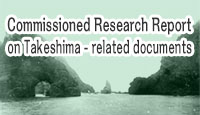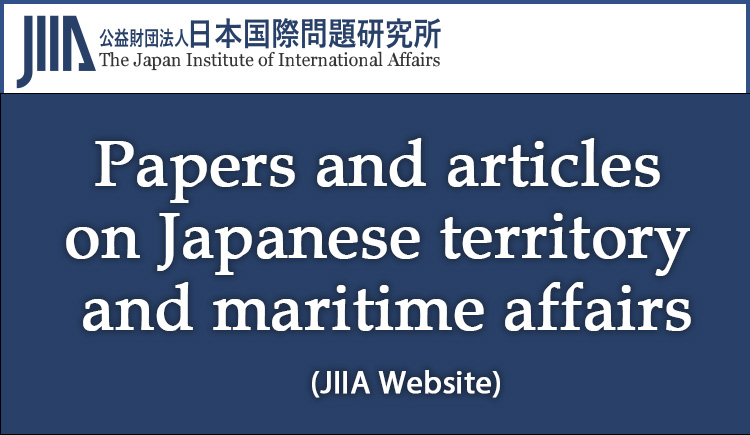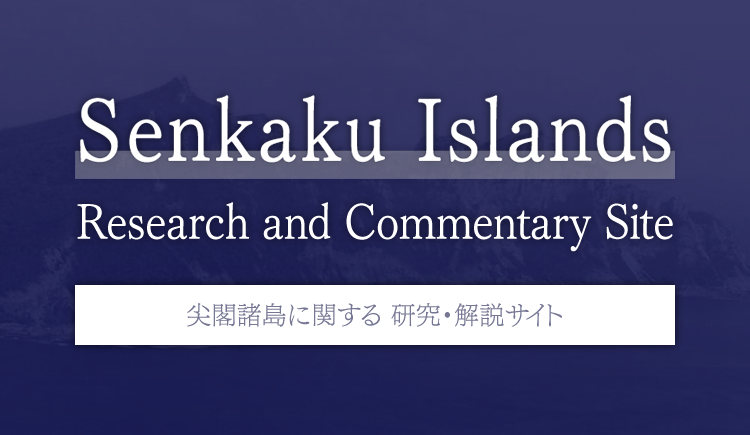The documents and materials published on this website were collected, researched, and prepared with advice from experts, as a part of a Government-commissioned project. The contents of this website do not reflect the views of the Government. Links to external sites (domains other than https://www.cas.go.jp) are not under the management of this site. For linked websites, please check with the organization/group that manages the website for the link in question.
Comprehensive issues
4 Preparation of the Joint US–UK Draft
The UK had been preparing its own draft of the Treaty of Peace with Japan separate from the US. The UK draft had a continuous line drawn on a map showing the range of Japanese territory: Takeshima was placed inside the line in the February 1951 draft, but was placed outside the line in the second draft of March 1951 and in the April 7, 1951 Provisional Draft of Japanese Peace Treaty (Article 1).10 The April 7 UK draft also prescribed the renunciation of Korea in Article 2.11
The US Department of State and the UK Foreign Office held discussions in Washington D.C. from April through May 1951, and the Joint United States–United Kingdom Draft of Peace Treaty was prepared on May 3.12 Article 2 of the joint US–UK draft reads, “Japan renounces all rights, titles and claims to Korea (including Quelpart, Port Hamilton and Dagelet), [Formosa and the Pescadores]. . . .” During the US–UK discussions, the US pointed out the psychological disadvantages of seeming to fence Japan in by a continuous line around Japan, and the UK agreed to drop its proposal in Article 1 of the above-mentioned UK draft.13 Also during the discussions, both sides agreed it would be desirable to only list the territories to which Japan was renouncing sovereignty. In this connection, it became necessary to insert the three islands Quelpart, Port Hamilton and Dagelet into Article 3 of the US draft.14 Thus, the understanding that Takeshima is Japanese territory was maintained in the joint US–UK draft as well.
Following further coordination through Dulles’ visit to the UK in June 1951, the Revised United States–United Kingdom Draft of a Japanese Peace Treaty was prepared dated June 14, 1951.15 The clause regarding renunciation of Korea came to read: “Article 2 (a) Japan, recognizing the independence of Korea, renounces all right, title and claim to Korea, including the islands of Quelpart, Port Hamilton and Dagelet.”
Note 10
Feb. draft: The National Archives (TNA) of the UK, PRO: Foreign Office Records, FO371/92532, FJ1022/97, p.58-; March draft: TNA, PRO: FO371/92535, FJ1022/171, p.70-; April draft: TNA, PRO: FO371/92538, FJ1022/222, p.14-.
Note 11
“Japan hereby renounces any claim to sovereignty over, and all right, title and interest in Korea, and undertakes to recognise and respect all such arrangements as may be made by or under the auspices of the United Nations regarding the sovereignty and independence of Korea.”
Note 12
Foreign Relations of the United States 1951, Vol.6, p.1024-.
Note 13
Department of State commentary in response to the opinion of New Zealand regarding Article 2 in the May 3 draft, in Japanese Peace Treaty: Working Draft and Commentary Prepared in the Department of State (June 1, 1951), Foreign Relations of the United States 1951, Vol.6, p.1061.
Note 14
United States Chapter III, in Anglo-American Meetings of Japanese Peace Treaty, Summary Record of Seventh Meeting held at 10.30 a.m. on the 2nd May, in Washington, TNA, PRO: FO371/92547, FJ1022/376, p.66.
Note 15
Foreign Relations of the United States 1951, Vol.6, p.1119-.
5 Request for Revisions from the ROK Government and US Denial
On July 19, 1951, Korean Ambassador to the US You Chan Yang visited Dulles and handed him a document addressed to US Secretary of State Dean G. Acheson requesting changes to the revised US–UK draft, as ordered by his government. Specifically, the ROK government requested that the word “renounces” in Article 2 Paragraph (a) should be replaced by “confirms that it renounced on August 9, 1945, all right, title and claim to Korea and the islands which were part of Korea prior to its annexation by Japan, including the islands Quelpart, Port Hamilton, Dagelet, Dokdo and Parangdo.”16
US Assistant Secretary of State Dean Rusk responded to this on behalf of the Secretary of State in a note dated August 10, 1951 which declined the ROK request as follows. “The United States Government regrets that it is unable to concur in this proposed amendment. The United States Government does not feel that the Treaty should adopt the theory that Japan’s acceptance of the Potsdam Declaration on August 9, 1945 constituted a formal or final renunciation of sovereignty by Japan over the areas dealt with in the Declaration. As regards the island of Dokdo, otherwise known as Takeshima or Liancourt Rocks, this normally uninhabited rock formation was according to our information never treated as part of Korea and, since about 1905, has been under the jurisdiction of the Oki Islands Branch Office of Shimane Prefecture of Japan. The island does not appear ever before to have been claimed by Korea.”17
The provision in the revised US–UK draft was adopted as Article 2 (a) unchanged, and this determined that Takeshima’s status as Japanese territory remained unchanged after the war as well.
Note 16
NARA, RG59, Lot54 D423, Japanese Peace Treaty Files of John Foster Dulles, Box 8, Korea. Also, Foreign Relations of the United States 1951, Vol.6, p.1206.
Note 17
NARA, RG59, Lot54 D423, Japanese Peace Treaty Files of John Foster Dulles, Box 8, Korea. Also, Foreign Relations of the United States 1951, Vol.6, p.1203, f.n.3.
6 Present ROK Claims and Their Propriety
Although the above are historical facts, and fundamentally cannot be refuted, the ROK has recently been making the following type of claim.18
The General Headquarters applied SCAPIN-677 (January 29, 1946), which provides that Dokdo, along with Ulleungdo, belongs to the area that is excluded from Japan’s governmental or administrative authority. The Allied Powers’ decision to exclude Dokdo from Japan’s territory was part of postwar measures to implement the results from the Cairo Declaration (1943) and the Potsdam Declaration (1945), which obligated Japan to renounce territories it had taken by “violence and greed.” Thus, Dokdo was rightly included as an area Japan should relinquish because it was Korea’s territory, which Japan usurped through violence and greed during the Russo-Japanese War.
These measures taken by the Allied Powers were succeeded in the San Francisco Peace Treaty signed in September of 1951. Even though Dokdo was not explicitly mentioned in the treaty, it is only natural to see Dokdo as having been included in the Korean territory that Japan should relinquish. Even islands larger than Dokdo were not all referred to in the treaty, because it was impossible to mention all the islands of the Republic of Korea.
Also the “Rusk Note,” upon which Japan bases its claim for sovereignty over Dokdo, has no legal effect in determining the holder of sovereignty over the island, as this note only reflected the opinion of the United States, not the opinion of the Allied Powers as a whole.
This claim does not hold either in terms of the facts or from a legal perspective. First, SCAPIN-677 of January 1946 removed Takeshima from the jurisdiction of the Japanese government under the Occupation, but this was a measure for occupation and not a disposition of territory. SCAPIN-677 itself includes the proviso (paragraph 6) that “Nothing in this directive shall be construed as an indication of Allied policy relating to the ultimate determination of the minor islands referred to in Article 8 of the Potsdam Declaration.” The disposition of territory was conducted by the Peace Treaty. To begin with, Takeshima was never Korean territory. There is little evidence for the ROK claim that “Usando” which appears in ancient Korean books and maps is Takeshima and that Takeshima was historically Korean territory, and so on.19 The ROK has also not presented any evidence of effective occupation of Takeshima. The claim that Japan took Takeshima lacks the premise (that Takeshima was Korean territory).20
Next, the Peace Treaty is interpreted in accordance with the ordinary meaning to be given to the terms of the treaty in its context and in light of its object and purpose (see Article 31 of the Vienna Convention on the Law of Treaties). Recourse may be had to supplementary means of interpretation, including the preparatory work of the treaty and the circumstances of its conclusion, in order to confirm the meaning resulting from the application of this method, or to determine the meaning when the interpretation through this method leaves the meaning ambiguous or obscure (Article 32 of the Convention). The “ordinary meaning . . . in its context and in light of its object and purpose” of Korea in Article 2 (a) of the Treaty of Peace with Japan is the Korea that was annexed to Japan in 1910, and does not include Takeshima. If additionally necessary, the meaning of this term “Korea” is confirmed and determined by the “preparatory work” presented in sections 2 through 5 above. The “islands larger than Dokdo” were not all referred to because they are included in the term Korea. The Rusk note has great significance as the preparatory work of the treaty (and it is not the opinion of the US alone).
Note 18
Northeast Asian History Foundation, ed.,“Truth 7,” Ten Truths about Dokdo not known in Japan, 2012.
Note 19
For details, see Takashi Tsukamoto, Takashi Tsukamoto, “Examining the Korean Government’s Claims with Regard to Sovereignty over Takeshima: A point-by-point analysis of the official publicity pamphlet ‘Dokdo, Beautiful Island of Korea’”, The Japan Institute of International Affairs, Japan’s Territories Series, Japan Digital Library (March 2017).
Note 20
SCAPIN-677 may have influenced the exclusion of Takeshima in the early Department of State drafts and UK drafts. In turn, SCAPIN-677 may have been influenced by the September 27, 1945 US Fifth Fleet Commander Memorandum No. 80, which was the predecessor of the MacArthur Line. (The text of the Memorandum is reprinted in Kenzo Kawakami, Sengo no kokusai gyogyo seido [The postwar international fisheries regime] (Dainippon Suisankai, 1972), 54–55.) This memorandum gives comprehensive permission for fishing operations within certain water areas in response to a September 26 request from the government of Japan. In setting the water areas in the Sea of Japan, as a result of drawing a straight line from the northern tip of Tsushima to 40N, 135E in the middle of the Sea of Japan, the line ran through Takeshima. Because this response was given one day after the request, it is clear this line was just drawn mechanically. The exclusion of Takeshima in SCAPIN-677 does not result from any judgment by the Allies that Takeshima is a territory that was taken by Japan.
Takeshima
Research and Commentary Site
- I Comprehensive issues
- II Commentary on themes by historical period
- III Analysis of claims by other countries





